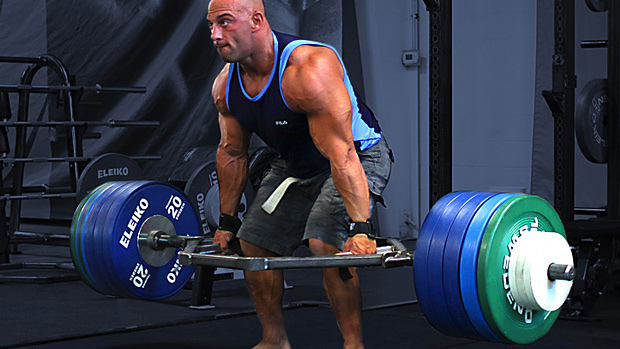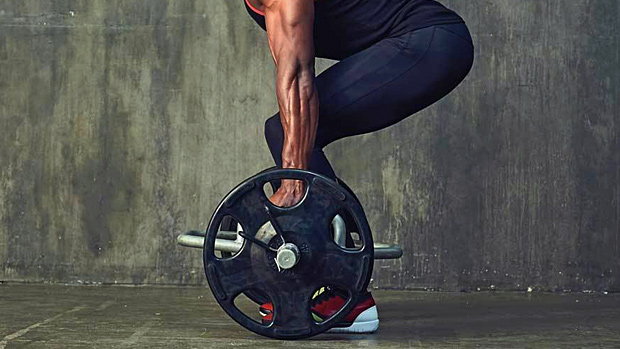CNS Stress and Trap Bar Deadlifts
Are trap bar deadlifts any less demanding on the central nervous system than barbell deadlifts? Well, let's look at what's likely to increase the stress on the CNS when lifting.
- The Weight Lifted: The more weight imposed on your body (tendons, skeletal system, muscles), the greater the demand will be on the CNS.
- The Work Performed: I'm not talking strictly about volume here, but more about the amount of work you perform when doing a movement. Work is equal to force X distance. That's why a partial lift is often less demanding on the CNS even if you're using more weight.
- The Amount of Muscle Involved: If more muscles are involved at the same time, the CNS will be challenged more. This happens in part because normally more muscles involved means heavier weight, but also because the system needs to work harder to coordinate all of those muscles.
- The Complexity and Coordination Required: The more difficult the technique is, the harder the CNS will work.
- Technical Efficiency: The less efficient your technique, the harder your nervous system will work to properly execute the movement. A better engrained motor pattern, and a more efficient movement, is more economical on neurological resources. That's one of the reasons why elite Olympic lifters with superb technique can snatch and clean & jerk every day.
- Speed of Execution: Both speed (more precisely, accelerating the bar) and mass moved will increase the demands for force production. Force equals mass x acceleration. So the more force you need to produce, the greater the demands on the CNS.
- The Perceived Stress: When the body sees a lift as potentially dangerous, either voluntarily or subconsciously, it'll produce more cortisol which leads to an increase in adrenaline production. More adrenaline production can lead to what we wrongfully refer to as "CNS fatigue" either by depleting dopamine (adrenaline is made from dopamine) or a desensitization of the adrenergic receptors due to overstimulation.
Now, using this info, let's compare the two.
Traditional Deadlift vs. Trap Bar Deadlift

- The Weight Lifted: Pretty much everybody will lift more on a trap bar deadlift, especially if using the high-handle position. So if we're talking strictly about using a certain percentage of your max, let's say 85% of your max on that lift, the trap bar "wins" this one.
- The Work Performed: If you're using the lower setting of a trap bar, the linear distance travelled will be the same as a conventional deadlift. However, the bar path is much straighter on a trap bar deadlift.
So while the distance from point A to point B is the same, the path is "longer" on the conventional deadlift, and the muscles should be under load for slightly longer. I give this one to the conventional deadlift. - The Amount of Muscle Involved: Conventional wisdom would say that since you're lifting more during a trap bar deadlift, more muscle is involved. But that's not the case. You're moving more weight mostly because of a better leverage: the center of mass is in line with your body, whereas in the conventional deadlift it's in front of you.
And because of that, the conventional deadlift works the posterior chain a bit more. The trap bar, on the other hand, will work the quads a bit more. I'd say the conventional deadlift tends to recruit slightly more muscle if done properly. Why? Because it recruits the lower and upper back a bit more. So I give this one to the conventional deadlift too. - The Complexity and Coordination Required: I have to give this one to the conventional deadlift. Technically speaking it's a more complicated lift because of the bar path.
You must lift up and in a backward arc to pass the knees properly. But you lift in a straight line during the trap bar deadlift. So assuming they're both done properly, a trap bar deadlift is much simpler than a conventional deadlift. - Technical Efficiency: Here it really depends on the lifter. If you're a master technician on the conventional deadlift it'll be no more demanding (in this category) as the trap bar deadlift. But because the trap bar is so much simpler and because most people have a very inefficient deadlift technique, this one normally goes to conventional too. But if your conventional deadlift technique is world class then both would be similar.
- Speed of Execution: This isn't really lift-specific; it depends on the load and the attempt to accelerate. If you want to be anal about it, the trap bar might be a bit easier to accelerate because of the straighter bar path. Both lifts would be similar in this variable, maybe a short "win" for the trap bar.
- The Perceived Stress: The conventional deadlift is significantly higher than the trap bar deadlift. The conventional deadlift will load the spine a lot more than the trap bar. That's because the load is positioned in front of you versus aligned with your body in the trap bar. Axial/spinal loading is one of the greatest stresses your nervous system can be under.
So as you can see, a trap bar deadlift puts a lower neurological demand on you compared to a regular deadlift. However, it would put a greater demand on you than a squat.





